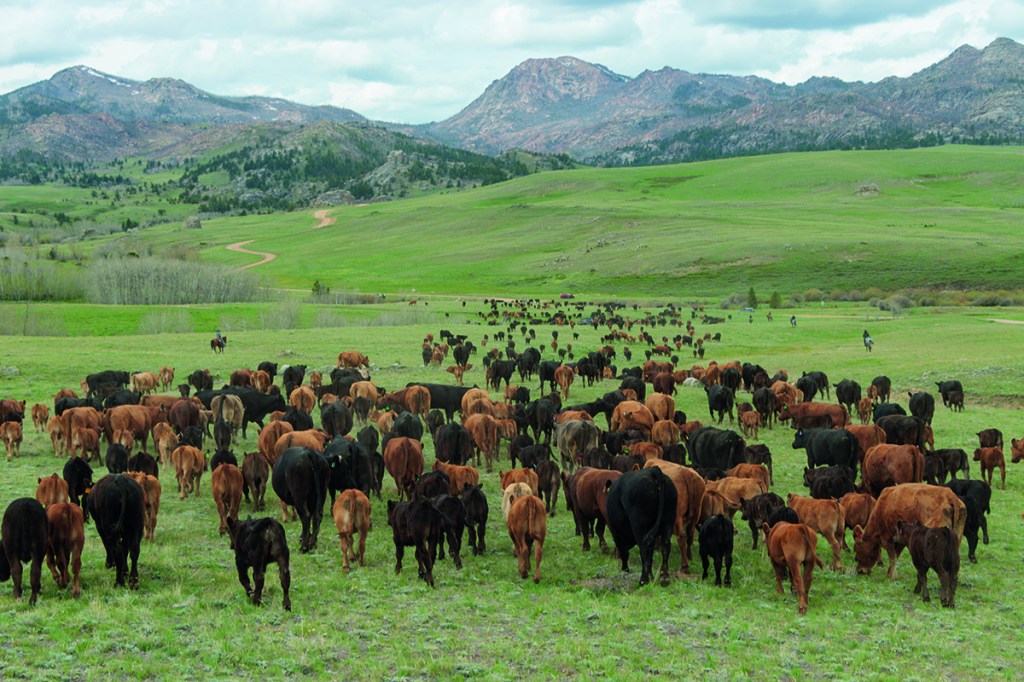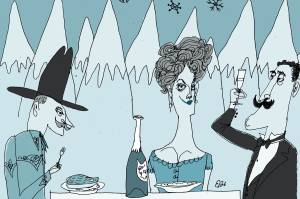This Memorial Day I found myself at a grassy spot along La Prele Creek, resting my horse and having lunch out of the back of a Ford Explorer, with an eclectic group of new friends who had also volunteered to help the Cross family on their annual spring cattle drive.
It was day two of the four-day feat, and John Ralph, one of the Crosses’ neighbors, sacrificed his own pressing chores to reinforce the cavalry.
“Is this typical, for neighbors to help each other?” I asked the soft-spoken stockman, his blue eyes accentuated by a grizzled beard, bright beneath the brim of his worn hat.
“Yes. Used to be a lot more of it,” he said. “Now there’s a lot less neighbors.”
The Crosses have lived near Douglas since 1883. Four generations ago, before Wyoming was a state, Shane Cross’s great- grandfather homesteaded the place. Today, Boot Ranch is run by Shane, who graduated from Stanford and the University of Virginia School of Law and moved back a few years ago to commit full-time to a life of unyielding hard labor, taking over the management of Boot Ranch from his eighty-one-year-old father Richard.
For most of that time, “managing” the ranch has been reminiscent of the hit television show Yellowstone (though the Crosses, being real ranchers, have much dirtier trucks than the fictional Duttons). Shane has been forced to add to the arduous duties of rancher, farmer, mechanic, vet tech, carpenter and accountant those of an attorney.
For years now, the Crosses have been contending with a barrage of lawsuits filed by Wagonhound Land & Livestock Co., a 300,000-acre megaranch owned by investment banker Arthur Nicholas. Nicholas, who’s worth at least $580 million, claims to live in Wyoming but has repeatedly found himself on the list of San Diego’s wealthiest movers and shakers.
At one point, Wagonhound filed four lawsuits simultaneously against Boot Ranch; one involved a five-acre parcel and was only settled when Shane relinquished the land.
The current lawsuit is critical to the Crosses’ survival; it involves Wagonhound’s determination to control three parcels totaling approximately 900 acres inside the Burnett Ranch, which Wagonhound cannot access without trespassing.
The Crosses began leasing the Burnett Ranch from the Burnett family for much-needed summer pasture in 2008, and they purchased the ranch in 2016. The Crosses trail their cattle on horseback seventy miles every spring from the Boot Ranch (5,500 feet elevation) to the Burnett Ranch (8,000 feet). Doing so is essential. Without the location change, the cows don’t have a cool place to graze and Boot Ranch grass cannot be cut for hay that feeds the livestock during the brutal Wyoming winters.
Wagonhound recently acquired deeds to the three disputed parcels, but the Crosses claim true ownership under Wyoming’s adverse possession law. The parcels have been fenced into and used by the Burnett Ranch for as long as anyone alive can remember, and no deedholder has used the parcels in at least 100 years. Wagonhound, though, seems intent on using its deeds to the land it can’t access to strongarm the family out of business. Wagonhound’s control of the parcels would likely have a domino effect: by outbidding the Crosses for public leases connected to the largest parcel, Wagonhound would leave them with half the ranch they have now and they could not continue their way of life.
Driving cattle into the mountains on horseback is becoming old-fashioned as trucks and ATVs replace the horse. But the Crosses must often venture where nothing but a sure-footed steed can go, so they continue to trail cattle the way they have for 140 years.
Old cowboy boots upside-down on fence posts let you know you’re nearing the entrance to the Boot Ranch. When I arrived at dusk, the setting sun was bathing the lush pastures in warmth and golden splendor. I found Jamie, Shane’s sister, at the barn, assigning horses and saddles to the right riders, choosing the right tack for the right horses.
After getting everyone set up for the next day, we were thrown together at a home-cooked, help-yourself supper at the Crosses’ — a log home built into the side of a hill overlooking scattered farm equipment, a barn, corrals, a few trucks, and acres upon acres of good, natural, healthy dirt. Inside there was a cozy collection of boots, coats, hats and dogs, of varying size and degree of wear, and pictures, books and sentimental curios documenting memories of the ranch.
We joked that the diverse group assembled outside at the large picnic table on the back porch could be the cast of characters in a whodunit: a defiantly chipper Australian ophthalmologist; a Colorado-based female firefighter; a retired textbook writer whose memory problems after a car accident render her unable to recognize faces; a veterinarian of Asian descent who lives in San Francisco, and me, a writer from Pennsylvania.
Shane Cross himself, a more masculine John Denver lookalike with the singer’s signature surfer hair but much better glasses, is also unexpected — at least in looks — as a rancher. And Jamie Cross, with her lithe build, delicate Nordic features and femininity is no beefy farm girl.
Yet there we all were, assembled by our mutual craving to trade the demands of daily office life to help some friends with a demanding and rewarding work-adventure. For four days, we would spend sunup to sundown on horseback, at times exposed to a relentless sun on a treeless road, winding round steep cliffs and over pastures, past magnificent rocky outcroppings, through a dense forest and across lots of brush, enduring heat, pouring rain, subzero windchills and a bone-chilling snowstorm.
We devoured breakfast burritos and coffee and rode away toward the hills at daybreak. Everyone seemed at ease on their horses, and I did my best not to be seen death-gripping my saddle horn at every undulation of terrain.
The task sounded simple: steer some cows onto a road. But first we had to find the cows, scattered with their new calves in a 1,200-acre pasture along steep, rocky bluffs and concealed in low-lying shrubbery. They’re damnably skittish, fond of staring at you as you approach, swishing their tails calmly, only to dart away at the last minute with an agility that defies their bulk, often taking several more animals with them.
At last, the cattle moved together onto the road (the road!), where we waited for them to pair up. In all the commotion, cows and calves inevitably get separated. (Think of releasing your toddler’s hand when the doors open at Walmart on Black Friday.)
Shane and Jamie showed us why they’re the professionals by pairing up and separating from the herd — which behaved like a school of erratic fish — twenty pairs of cows that were unhealthy or missing the Bar Open A brand. We then released the rest to advance.
They moved all right, and for a while I felt like a member of the Magnificent Seven as we rode abreast and 800 muscly beasts submitted to the will of puny humans.
The adrenaline rush was short-lived.
Imagine you’re a linebacker who’s been beaten downfield by a speedy running back. The entire defense turns to assist you in the chase of the offensive player. Then, the next thing you know, the entire opposing team and 768 of its fans are charging in the direction you didn’t want them to go. In the cattle-drive world, this is called a stampede. And we experienced three of them.
At one point, the cows stretched into a spaced-out string that was no more a “herd” than I am a horsewoman. One upside to these ongoing stampedes was that in the heat of the moment, I forgot my fear of falling off my horse and rode with abandon after the wayward animals, trusting my mount’s instincts. I must have done something right; a passing Missouri tourist was sure enough I was the real deal to snap my photo.
The skilled riders reunited the separated pairs and sent the rest of us back to the ranch. I was beat. My theory that there’s nothing comfortable about horseback riding was confirmed. I was saddle-sore. Dehydrated. Windburned. My right stirrup was too short and my knee was strained at an awkward angle all day. My boots rubbed against my saddle and against my calf and rubbed a raw spot in my skin. My obliques ached from supporting myself and twisting in ways I wasn’t used to. Before this trip, I considered myself a generally rugged person, but I learned being “Western tough” is a standard all its own.
I skipped dinner that night and collapsed in the bunkhouse for ten hours. To my wonder, I wasn’t in pain at all the next morning, and after adjusting my saddle, enjoyed three more days of cattle-driving that are some of the most invigorating and satisfying moments I’ve ever known.
I felt carefree — not careless, but focused solely and intently on the task at hand, which alternated between getting in the way (of the cows) and not being in the way (of the competent cowhands), admiring the dramatic skies, inhaling the perfume of the sage crushed underhoof and gaily engaged in the company of my comrades.
Jamie orchestrated the symphony, relaying intel from Shane, who rode ahead and strategized with Richard, ever-present as a wealth of wisdom in his ATV (along with three dogs). The country grew rougher and more majestic, and the elements, too, increased in intensity. A sudden cloudburst ended the third day in chilly, muddy sog.
The fourth and last day: the road grew narrower, steeper, more treacherous. Huge rocks and trees closed in like walls as we ascended. So did a sense of heightened excitement. We were nearing the end. We were in the mountains we had squinted at from afar mere days before.
After the final, most punishing push of all up a steep grade, we emerged from the trees to an open meadow. On top of the world in the “summer” pasture, a driving wind and blinding mix of snow and sleet pelted our faces. We’d done it. We’d pushed 800 half-wild, half-ton animals seventy miles. We couldn’t lose even one. We couldn’t get hurt. We had to stay together and not get lost but not get so close that a horse could bite or kick and injure another. We had to yell — at each other and at the cows and at the dogs. We had to stay friends when tensions ran high, danger loomed, and exhaustion overtook us.
We’d endured every emotion — joy, fear, frustration, defeat, wonder — and at last, elation at having completed a monumental task — a rarity in our digital age. I felt triumphant at having survived, but I remembered that for the Crosses, this is daily life. There is no putting it off until tomorrow or not getting around to it. John Ralph, the Cross family and others endure degrees of this life day-in and day-out, year-round. And the Crosses are fighting tooth and nail to be able to keep doing it.
The character of the community has changed dramatically since largely absentee investors began to buy up old family ranches in Converse County. The established people don’t have to sell, of course, but once a handful of struggling families gives in to an attractive offer, it makes things much harder on the holdouts: fences go up, lots are resurveyed, longstanding rights-of-way are blocked off and neighborly traditions disappear.
“It’s getting harder to find the John Ralph experience — where you have a few neighbors who will bend over backwards for you because that’s just what you do, and they’re good people,” Shane told me.
The ultrawealthy have been gobbling up massive tracts of rural lands in recent years. “Farmer Bill” Gates owns more private farmland than anyone else in America. Ted Turner’s private bison herd is the largest in the world. Last year, Rupert Murdoch splashed out $200 million to buy a 340,000-acre cattle ranch in Montana.
“Today, just 100 families own about 42 million acres across the country,” a 2019 New York Times article reported, and “the amount of land owned by those 100 families has jumped 50 percent since 2007.”

His coat caked in snow and mud on his glasses, Shane flashed a gratified grin and leaned out of his ATV (the windshield was too filthy to see through) to take me to see the land inside the Burnett Ranch that Wagonhound claims is theirs. From there we could see six counties and Colorado in the distance. Shane pointed out a couple of old homesteads dotting the place and outlined the disputed parcels.
Such “inholdings” were once common in the West, as homesteaders acquired patchwork parcels of land from other settlers who left. Typically, trades were worked out, or, as in this case, deedholders simply abandoned them.
The Crosses offered to buy or lease the parcels from Wagonhound, or to trade other property for them. Wagonhound refused. During the trial last October, Arthur Nicholas testified that he was “not sure” where the Burnett Ranch is and he is “totally comfortable buying any ranch without ever having set one foot on it or seen it.” He also testified that he believed he had flown over the parcels and that he did not recall ever physically being on the Burnett Ranch because that is “not important” to him.
Wagonhound’s website says the ranch’s vision is “to honor tradition” and “remain steeped in history.” But it’s hard to see Wagonhound’s behavior as anything but greedy bullying. The case is being appealed to the Wyoming Supreme Court after a district court ruled against the Crosses. My requests for comment from Wagonhound went unanswered.
Shane, relaxed after the cattle drive, surrounded by family and friends and holding his one-year-old son, explained what keeps him going.
“It’s our home. And we want to keep doing this. Now it means even more to me because I want Dake [his son] to be able to do it. If you think of the stuff we’re doing right now, imagine what this guy did, when they didn’t have four-wheelers and shuttle trucks,” he said, motioning to Richard. “Growing up and hearing their stories and learning about it just makes you develop an incredible sense of pride. Doing a good job and working hard, thinking of the heritage and what my ancestors went through — anytime times get tough, when you come from that, we’re not going to shy away.”
This article was originally published in The Spectator’s July 2022 World edition.


















